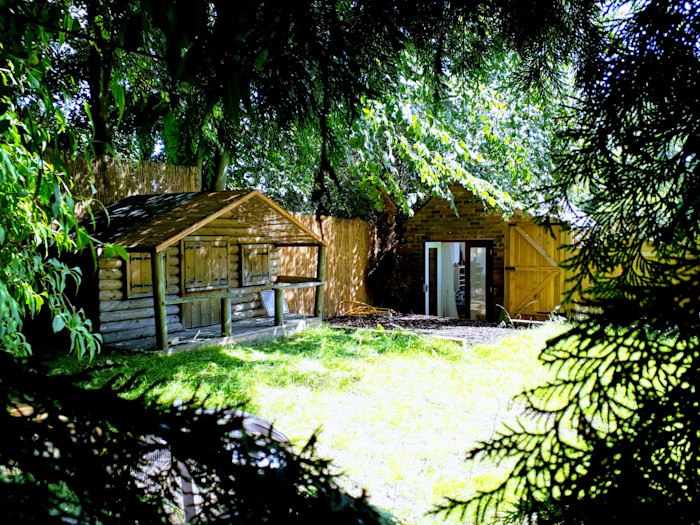
Nature and being outdoors has always been part of my life, although it feels most connected to my stepdad (who sadly died in October 2021). He was a decorator and signwriter and painted my therapy room, but he was also an entomologist who almost rejected sitting still indoors; he was someone who fully restored a 17th Century woodland cottage and then rented it from the National Trust for over 40 years, with electricity only coming from a temperamental windmill in the garden, hot water generated by the Rayburn, food cooked on an open fire, and a toilet in the shed. I spent my childhood weekends (from about age 9) in this space, feeling safe walking through the woods, alone except for my stepdad’s dog, connecting with and learning about nature. I spent many hours sitting at the top of the sweet chestnut tree in the garden, and last year I took my one year old daughter to visit this wonderful place.
Nature connection for me is a multitude of different things; it’s about being in nature and feeling secure, comfortable, and relaxed; it’s about respecting nature – its power and strength as well as the living organisms; it’s about being able to make use of natural things without stripping it bare; it’s about leaving spaces to be wild and free. My childhood was spent largely outside, walking barefoot, playing in mud, camping, cooking on fires, climbing trees. I then went on to take this love in to my work – working in outdoor centres, becoming a ropes course instructor, teaching with an emphasis on outdoor adventure and learning outside the classroom, becoming a Forest School practitioner, and eventually taking my play therapy outside. I also wrote my final research essay for my Play Therapy diploma on taking Play Therapy outside before the wonderful books by Ali Chown were published.
Writing about outdoor therapy and actually putting it into practice are two very different things though. There's the lists of things I needed to consider, and then the actual consideration of those things. Again, I have many conversations with people about taking therapy outside, and what is necessary to consider, from a practical point of view and a personal point of view. Every outdoor therapist will have different boundaries, different experiences and different needs.
For me, the main things I needed to consider for taking therapy outside were as follow:
Risk/benefit assessments:
At most points in my career as a primary school teacher, forest school leader, outdoor development tutor, and high ropes course instructor, risk/benefit assessments have played a key role. Taking this experience into consideration, my assessment (both benefits and risks) of my outdoor space included:
confidentiality
weather - including appropriate clothing/equipment for weather and who provides it
uneven/slippery ground
falling branches
animal faeces/mud/litter
thorny/stinging/toxic plants
stinging/biting insects
client/therapist medical conditions
contact with animals
shelters/equipment stored outside
outdoor electrics
specific activity risk assessments - shelter building, tool use, fires, tree climbing etc.
what is/isn't covered by insurance
I also consider the risk and benefits of specific clients being outside - their connection to nature already, their experiences, what it means to them; and the same for myself.
Confidentiality: This is always a really odd one when sessions need to be confidential. Because most of my work is through play, through metaphor and through relationships, it's unlikely that anyone watching would really know what was going on. It's about the connection and relationship of the therapist and client; it's about understanding my client's way of expressing themselves so even if we did outdoor play therapy in a public space, very little would probably be shared. That being said, my therapy space is also my garden and I live in a terraced house so have neighbours on both sides. It's also a popular place that people walk and so will have people passing outside my driveway. My clients' parents are waiting in cars on the driveway, often with windows open in hot weather. There's also the potential of my own family overhearing what is going on. I have tried to make my outdoor space as visually confidential as I can - it is enclosed with fences/plants/trellis on all sides, and this part of my garden is not used by my family on work days. It is only accessible from my therapy room when working because I have internal bolts on the gates/doors. I cannot make my space sound proof however, and so I explain to my clients that, in general, people cannot see into the space however if they are nearby, they can probably hear what we are talking about. For most clients, that honesty and knowledge is enough, and some have specifically taken me indoors to talk about something (though not possible during covid and social distancing restrictions), or we have built additional shelters so that people can't see or hear us.
Additional training:
My play therapy training was all focussed on being indoors, the container of the room. In fact, in my first year, we were actively discouraged from taking therapy outside. However now it feels as though additional training would depend upon a therapist's current level of experience and competence in the outdoors. For me, working outdoors is something I have always been passionate about. I already had completed my Forest School leader training before I took therapy outdoors, and lots of this overlaps. I also chose to do a week long forest immersion course with Hayley Marshall and Martin Jordan - outdoor counsellors/psychotherapists rather than play therapists. I learnt a lot from this course, which deepened my connection with working outdoors therapeutically and probably valued this course the most for my personal development too (this was back in 2012). I did a 3 day course on nature as co-therapist, again with general adult counsellors rather than play therapy (also probably 2011/2012). More recently (2021) and 2 years after starting doing Play Therapy outdoors, I completed the Best Practice in Outdoor Play Therapy led by Ali Chown in association with the Collaboration of Outdoor Play Therapists (COOPT) and a zoom course during lockdown with Mashe Bennet about taking clinical supervision outside.
Boundaries:
A huge consideration for me was my toolkit - what from outside can come in? What from inside can go out? And does this depend on the weather? In fact, how does the weather affect my outdoor sessions - will we go out in the rain? The snow? The ice? If the client isn't suitably equipped (coat, gloves, sun cream etc), is outdoors removed as an option? Who's responsibility is it to ensure they have all that they need? So many questions which didn't necessarily have simple or immediate answers.
My cat:
How would I handle this? I had made a decision a while back that my cat wouldn't be allowed inside my therapy room, but he roams the garden freely. He has got into client's cars, he has welcomed them at the door, but equally at times been terrified of new faces. Animal assisted play therapy (with a heavy focus on dogs and horses in the training I've seen) is a whole other modality of therapy but one wasn't convinced I wanted to go down, but my cat didn't understand that and continued to join us when sessions ended up outdoors.
So now I have strict rules with clients on how to interact with my cat which are on display in my room and shared at the outset (along with questions in the initial interview about allergies and experiences with animals), and shared again if they see my cat and show an interest. My cat is spooked easily, and often runs away, so can build an amazing connection with clients, helping them to slow and calm, and we can also speak through metaphor about my cat, wondering what he might have been scared of, what could help, what he might need (all the questions I'm really thinking about in terms of my clients).
Taking therapy outside has been everything I wanted it to be, even in the pouring rain. I'm glad to have the option of going back indoors now (something that didn't feel safe a year ago), and love the option of using both spaces interconnectedly. As I continue on this journey, I am always learning and discovering new things about myself, my clients, my supervisees and the world around me. I think, perhaps, the most recent learning curve is within my work with those clients, parents and supervisees who don’t have a strong connection with the outdoors. The clients who run for shelter at the first drop of rain, the parents who were unsure on the appropriate clothing to send for different types of weather, the supervisees who talk about the importance of natural objects in their toolkit but wanted to meet over Zoom rather than in the outdoor shelter during Covid restrictions. When nature and the outdoors has been such a natural and integral part of my life, it’s easy to take for granted that other people will have had the same experiences and outcomes. Over the past 2 years, particularly when I chose to keep my indoor space closed, I’ve noticed how much more my verbal reflections are linked to the experience of being outdoors (whether positive or negative), helping clients feel safe, free and connected, and hoping to also protect nature too (from the desire of some clients to smash, rip and squish). I’ve also found that, despite my room now being available, the outdoors is used so much more during sessions than it was pre-covid. I don’t know whether that’s because of my change in reflections and confidence or my clients, but hope these connections continue to be forged for years to come.
